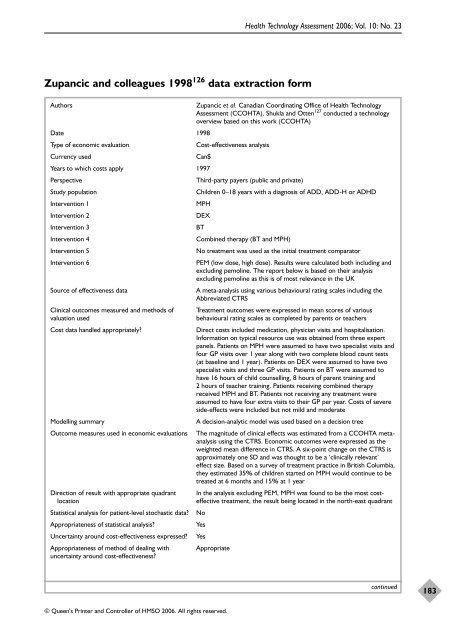APPENDICES. A systematic review and economic model of the ...
APPENDICES. A systematic review and economic model of the ...
APPENDICES. A systematic review and economic model of the ...
You also want an ePaper? Increase the reach of your titles
YUMPU automatically turns print PDFs into web optimized ePapers that Google loves.
Zupancic <strong>and</strong> colleagues 1998 126 data extraction form<br />
© Queen’s Printer <strong>and</strong> Controller <strong>of</strong> HMSO 2006. All rights reserved.<br />
Health Technology Assessment 2006; Vol. 10: No. 23<br />
Authors Zupancic et al. Canadian Coordinating Office <strong>of</strong> Health Technology<br />
Assessment (CCOHTA). Shukla <strong>and</strong> Otten 127 conducted a technology<br />
overview based on this work (CCOHTA)<br />
Date 1998<br />
Type <strong>of</strong> <strong>economic</strong> evaluation Cost-effectiveness analysis<br />
Currency used Can$<br />
Years to which costs apply 1997<br />
Perspective Third-party payers (public <strong>and</strong> private)<br />
Study population Children 0–18 years with a diagnosis <strong>of</strong> ADD, ADD-H or ADHD<br />
Intervention 1 MPH<br />
Intervention 2 DEX<br />
Intervention 3 BT<br />
Intervention 4 Combined <strong>the</strong>rapy (BT <strong>and</strong> MPH)<br />
Intervention 5 No treatment was used as <strong>the</strong> initial treatment comparator<br />
Intervention 6 PEM (low dose, high dose). Results were calculated both including <strong>and</strong><br />
excluding pemoline. The report below is based on <strong>the</strong>ir analysis<br />
excluding pemoline as this is <strong>of</strong> most relevance in <strong>the</strong> UK<br />
Source <strong>of</strong> effectiveness data A meta-analysis using various behavioural rating scales including <strong>the</strong><br />
Abbreviated CTRS<br />
Clinical outcomes measured <strong>and</strong> methods <strong>of</strong> Treatment outcomes were expressed in mean scores <strong>of</strong> various<br />
valuation used behavioural rating scales as completed by parents or teachers<br />
Cost data h<strong>and</strong>led appropriately? Direct costs included medication, physician visits <strong>and</strong> hospitalisation.<br />
Information on typical resource use was obtained from three expert<br />
panels. Patients on MPH were assumed to have two specialist visits <strong>and</strong><br />
four GP visits over 1 year along with two complete blood count tests<br />
(at baseline <strong>and</strong> 1 year). Patients on DEX were assumed to have two<br />
specialist visits <strong>and</strong> three GP visits. Patients on BT were assumed to<br />
have 16 hours <strong>of</strong> child counselling, 8 hours <strong>of</strong> parent training <strong>and</strong><br />
2 hours <strong>of</strong> teacher training. Patients receiving combined <strong>the</strong>rapy<br />
received MPH <strong>and</strong> BT. Patients not receiving any treatment were<br />
assumed to have four extra visits to <strong>the</strong>ir GP per year. Costs <strong>of</strong> severe<br />
side-effects were included but not mild <strong>and</strong> moderate<br />
Modelling summary A decision-analytic <strong>model</strong> was used based on a decision tree<br />
Outcome measures used in <strong>economic</strong> evaluations The magnitude <strong>of</strong> clinical effects was estimated from a CCOHTA metaanalysis<br />
using <strong>the</strong> CTRS. Economic outcomes were expressed as <strong>the</strong><br />
weighted mean difference in CTRS. A six-point change on <strong>the</strong> CTRS is<br />
approximately one SD <strong>and</strong> was thought to be a ‘clinically relevant’<br />
effect size. Based on a survey <strong>of</strong> treatment practice in British Columbia,<br />
<strong>the</strong>y estimated 35% <strong>of</strong> children started on MPH would continue to be<br />
treated at 6 months <strong>and</strong> 15% at 1 year<br />
Direction <strong>of</strong> result with appropriate quadrant In <strong>the</strong> analysis excluding PEM, MPH was found to be <strong>the</strong> most costlocation<br />
effective treatment, <strong>the</strong> result being located in <strong>the</strong> north-east quadrant<br />
Statistical analysis for patient-level stochastic data? No<br />
Appropriateness <strong>of</strong> statistical analysis? Yes<br />
Uncertainty around cost-effectiveness expressed? Yes<br />
Appropriateness <strong>of</strong> method <strong>of</strong> dealing with Appropriate<br />
uncertainty around cost-effectiveness?<br />
continued<br />
183
















